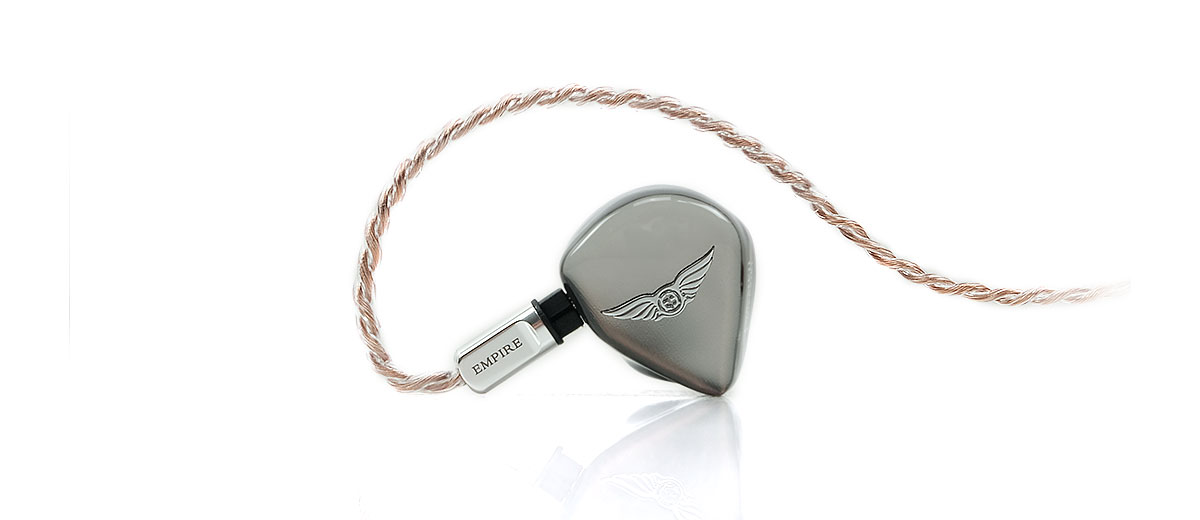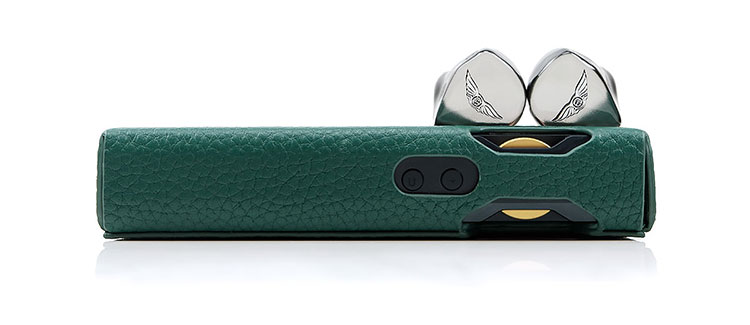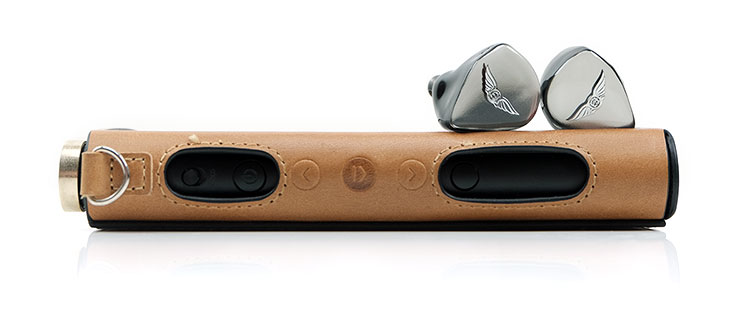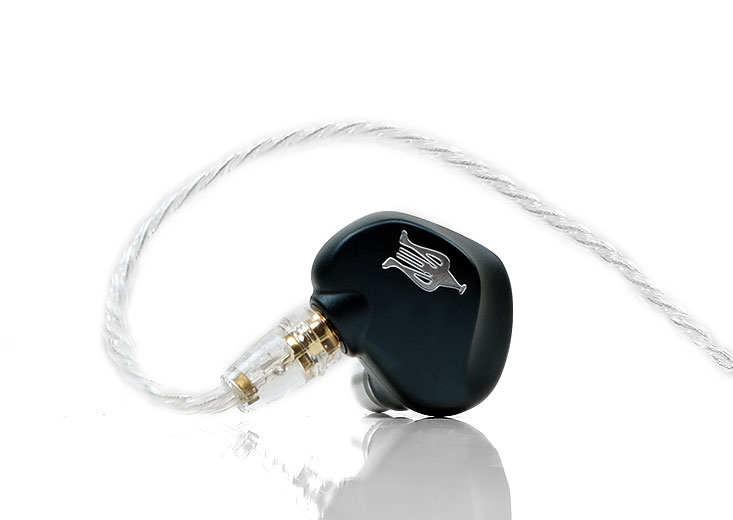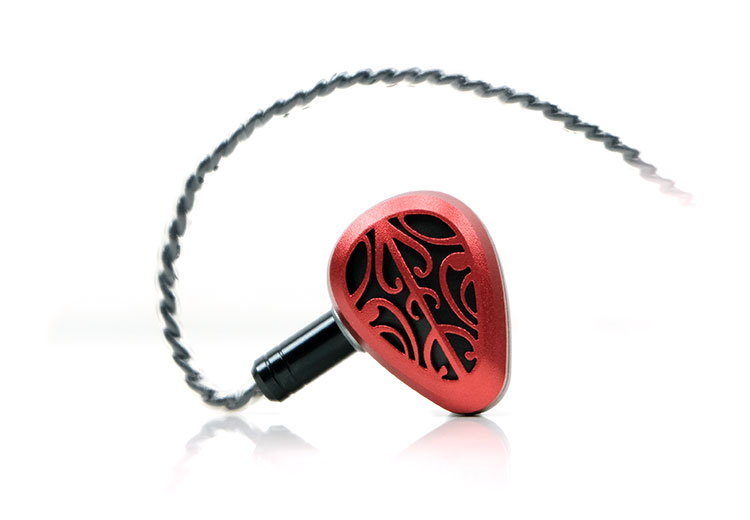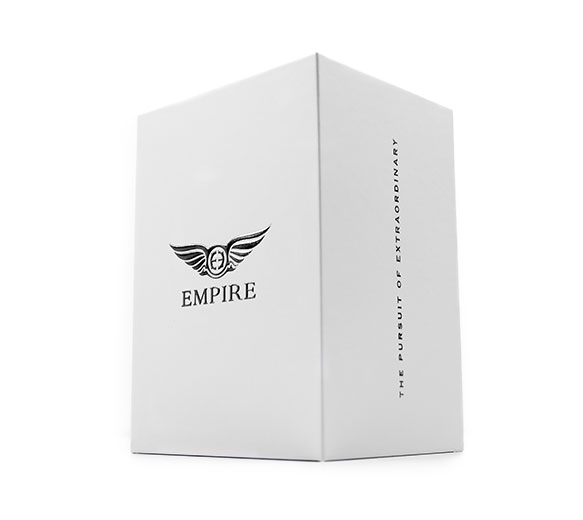Sound Impressions
Summary
I have always come to associate Empire Ears monitors as bleeding edge in terms of sonic profiling, never a signature that does anything by half measure and always willing to push the envelope one way or another.
The ESR MKII might be a bit of a freak then because it is perhaps the most balanced tuning I have heard from the company to date. If the external design could be considered an executive vibe, then the sonic profiling is likewise a mature and astute delivery.
This is a tone relatively neutral through the bass and mids and cleaner with an almost high-fidelity performance from the highs. And yet, it is not a bright or harsh-sounding monitor, not by a long shot.
The word pure comes to mind in terms of how to describe the harmonic balance and light touch from the ESR MKII sound signature. It is an incredibly articulate, tight, well-defined, and highly resolving 5-driver monitor.
The basic FR is relatively controlled on the low-end with a very subtle elevation up to 200Hz giving the bass a bit of welcome body and warmth which does play an important role in preventing the ESR MKII from sounding too sterile or dry.
From there is does a little dip in the lower-mids sub-1k before a stronger 1-4k elevation for a forward midrange and vocal presence. Treble lift is tilted more to the upper than the lower with more of an 8-10k peak and a dip in the lower treble, (5-7k).
That lower-treble drop does a lot to suppress any potential upper mids instrumental and vocal sharp overtones without sucking out needed air.
Timbre
This is a beautifully sweet-sounding but somewhat delicate timbre, light in body but with an attack just on the right side of liquid to prevent it from sounding lush. You also get a typically quickish balanced armature style of decay and even more speed in the highs with the EST drivers.
The ESR MKII subtle mid-bass rise injects some necessary natural warmth into instrumental and vocal timbre but not so much to skew the excellent harmonic balance. Instrumental notes are fast, with beautiful separation but with neutral weight.
Vocals come across as clean and clear with just the right level of warmth to err to the natural side rather than the bright or harsh side. What I find particularly charming about the ESR MKII upper-mids timbre is the ability to keep it clean and precise without emphasizing sibilance or allowing the percussion to sound splashy and dominating.
Credit for the EST driver tuning and the way it overlaps with the BA tuning. The ESR MKII is very clean and well extended on the highs but lacking in any sharpness. It offers more of that classic high-fidelity pureness so you get plenty of detail and some excellent resolution but it is not typically aggressive or forward sounding to achieve that.
Staging
The ESR MKII staging performance is more about width and height than depth but it is heavy on incredible separation and teasing out those nuanced little spatial cues.
The BA low-end drivers are tight, well defined, and just slightly north of neutral to give it a natural weight to low-pitching rhythm instrumentation without dominating. Still, if you are looking for heavy power the ESR MKII is not the best EE pick out of the range. The likes of the Valkyrie MKII and the Hero are heavier hitters in that regard.
The mids forward tuning pushes anything from 1-4k further forward so vocals are much more to the fore with the instrumental body a light lighter in weight and behind giving it a stretched and slightly holographic feel. The lightness of the tuning and that slight dip in the lower mids combined with the controlled bass keeps everything wonderfully clean and clear.
The final mention is air, the ESR MKII has tons of it. Not in a grandiose manner, it is not a huge soundstage but rather this is a precision staging quality, with notes that can ‘turn on a dime’ and not bleed into each other.
Complex arrangements are not a problem for the ESR MKII with every little detail coming through in a very pleasing manner. These EST drivers are perfectly phased with the BA timbre and sound very coherent to my ear with just the right level of high-frequency energy.
Synergy
Efficiency
The ESR MKII is rated at a very low 3.9Ω impedance and a fairly sensitive 111dB SPL. The low impedance is no longer surprising with recent releases from Empire Ears at a similar level such as the Valkyrie MKII and the Odin which were even lower at 3Ω.
This is a monitor that will not require too much of a voltage swing to sound optimal and at 111dB SPL, it will require more current than the 5-driver Campfire Audio Andromeda but more resistive to background hiss on higher noise floors and still classed as quite efficient overall.
With regards to sensitivity to noise and background hiss we tested the ESR MKII with 5 different DAPs in both SE and balanced output mode. This included the iBasso DX300, HiBy R8, FiiO M15, the LP P6, and the Lotoo PAW Gold Touch. All 5 in SE offers next to no hiss or detectable noise with the ESR MKII.
Switching to a balanced Alpha IV, the performance was equally as impressive with only the very faintest of noise detected on the M15 4.4mm output but nothing I would ever classify as an overt hiss. The rest of the DAPs also had very low noise floors delivering very black backgrounds with the EST MKII.
Pairings
The ESR MKII is an extremely flexible monitor with the type of tuning that works well with most sources. In reality, it is just going to be a preference thing in terms of the synergy from the potential pairing since noise and power are not huge factors.
My one constant though with any pairing is detail. The ESR MKII excels with sources that offer black backgrounds, excellent dynamic range, and high levels of resolution.
Natural/Analog Sources
For example, my own personal preference was the LP P6 simply because of the way it fleshes out the BA timbre a lot better than most delta-sigma variants outside of the DX300.
BA timbre can be a light touch with not the broadest of texture or fullest of sounds but the P6 did a great job of countering that with a very analog but sweet overtone. You will be hard-pressed to tease some sibilance out of this pairing yet the extended EST highs are gorgeous and very clear at the same time.
The ESR MKII/DX300 pairing was also very relaxed in tone with a slightly sweet-sounding timbre and low on harmonic dissonance in the upper mids and highs. This pairing has a slightly lighter note compared to the P6 pairing but with a little more treble sparkle. Overall, this is a smooth but very detailed and complex staging quality to the pairing.
The HiBy R8/ESR MKII is not quite as well separated as the DX300 but it will give you a bit more of the P6 weight on the low-end, perhaps even more so. Mids are a little more laid back and the treble slightly cleaner sounding but once again, a very pure high-fidelity tone throughout the treble with a satisfying harmonic balance.
Neutral Pairings
I suspect some might prefer more neutral-sounding DAPs given how well the ESR MKII’s resolves with its fast articulation and excellent separation. I was expecting the M15 to deliver something a little harder-edged and brighter but in all honesty, I found the tone to be quite accurate.
I suspect the sliver of warmth from the ESR MKII mids is keeping things nicely in check around the upper mids area where the M15 can push a little harder than the warmer-sounding DAPs.
If you do want a bit more beef in the mids and a better body on the treble, the Lotoo PAW Gold Touch is probably the better choice here. It is still technically a neutral DAP but it’s got more physicality than the M15 for instrumental notes and a little more forwardness in the mids. The ESR MKII likes forward mids a lot.
Select Comparisons
Meze Rai Penta
$1099
Technical
The Rai Penta is bang on the money in terms of pricing versus the ESR MKII and is also a 5-driver hybrid universal monitor. However, internal things are quite different.
The Rai Penta uses a single 10mm dynamic driver and a quad balanced armature setup. I am presuming a 3-way crossover with the dynamic driver for the lows and 2 BA for the mids and 2 BA for the highs.
The ESR MKII ditches the dynamic and goes with a triple balanced armature for the lows, mids, and highs combined with a dual EST split into the highs and ultra-highs.
A few other subtle differences between these two monitors internally. The Rai Penta opts for a precision milled sound bore finish using variable-length steel tubes whereas the ESR MKII opts for the A.R.C or Anti-Resonance Compound for internal damping.
Also, because of the use of a dynamic driver, the Rai Penta uses their uses a dual venting system in front and behind the assembly whereas the ESR MKII BA and EST mix require none of that.
Design
Two very different designs here. The Rai Penta is beautifully sculpted from CNC milled aluminum and finished in a dark navy color with nuanced curving and a milled logo to the front.
The ESR MKII has a lighter acrylic and resin build with a black underside and that executive faceplate consisting of a thin film of brush silver CNC aluminum and the 3-dimension EE logo hovering above. The Rai Penta is quite a bit small and stubbier than the ESR MKII but the aluminum design means it is also heavier.
The Rai Penta also seems to be a bit more challenging to get a good seal compared to the ESR MKII. The supplied foam tips just do ok but with some gaps, whereas Final E tips with the XL fitting do much better. Pity the Rai Penta does not come with Final E tips though.
The ESR MKII’s lack of venting ports, deeper nozzle, and better tips do a much better job in terms of isolation. Though both are quite comfortable in the ear the gap is huge between these two in terms of passive noise isolation.
The final difference is the cable option. The Rai Penta uses MMCX and a 1.2m 4-wire SPC in a 20-strand Litz configuration with some tight braiding inside a translucent PVC jacket. The ESR MKII also uses a 4-wire but with different materials. The Alpha Hybrid IV instead uses a 26AWG multi-size UPOCC Litz copper strand geometry with 0.78mm 2-pin connectors.
Performance
There are a couple of things happening with these two monitors that mark them out as quite different.
The first is the low-end dynamic driver of the Rai Penta, it offers a different type of timbre to the BA of the ESR MKII. It does have a bit more ‘bounce’ or physicality, a slightly longer delay, and a bit more body.
That means the Rai Penta is going to have a little more depth and a little more warmth in its staging and timbre. You can hear that in the midrange where the Rai Penta is richer sounding, a bit smoother even with the switch to the BA timbre. It is a very likable euphonic timbre, not as rounded as the Gae Bolg, (see below), with little in the way of emphasized sibilance.
Treble is faded compared to the livelier and more extended ESR MKII tuning. You get less air through the upper mids with a 2-6k dip in the Rai Penta so percussion is a little muted as is headroom in general. The ESR MKII keeps the energy high through the mids and with some nice pure sparkle from the upper treble also and much better headroom.
However, the second impression is my overriding opinion on these two monitors’ drivers and overall configuration, at least on a technical level.
Personally, I think the ESR MKII uses a better set of drivers or a more optimized driver and chamber combination. The dynamic range is superior, the background is blacker, the transient response and the overall level of articulation just that bit faster. Everything simply sounds more vivid, more impactful, and not just because it has a cleaner sound signature.
Campfire Audio Andromeda 2020
$1099
Technical
The Andromeda 2020 is something like the 3rd or 4th revision of the original but it still retains that same classic look and more or less the same internal configuration.
Like the ESR MKII, the Andromeda 2020 is a 5 driver monitor. However, unlike the ESR MKII’s hybrid design, the Andromeda 2020 is an all-BA driver build with a T.A.E.C. configuration of 2 for the highs, one balanced armature for the mids, and 2 for the lows.
This contrasts with the ESR MKI’s triple BA for the lows, mids, and highs and dual EST split between the highs and ultra-highs.
Aside from driver configurations, both monitors have plenty of other in-house technology. For Andromeda, this includes a tubeless T.A.E.C chamber for the highs and an optimized 3D construction which also includes a 3D printed ‘Solid Body’ internal acoustical chamber design.
For the ESR MKII, the focus is blending the two driver types smoothly via EE’s patented 4-Way synX Crossover Network and their EIVEC technology for the EST drivers. A.R.C is also used to further help with damping the internals.
Design
The iconic green aesthetic has stood the test of time in terms of ‘pop’ though the form factor of the Andromeda 2020 is still a little on the acquired taste side.
The zirconium blasted aluminum shell lacks the lighter more aggressive contouring of the ESR MKII acrylic main shell so the fit is not quite as smooth and snug. The Andromeda 2020 is a bit heavier than the ESR MKII also and you will feel that in the hand and in the ear.
CA did bring in longer nozzles with this new version so it’s an easier fit and not uncomfortable. However, aluminum is simply not as pliable as acrylic in manufacturing to account for those nuanced curves in your ear so the ESR MKII does cover the gaps better with superior isolation.
Cables and connectors are very good quality 2nd gen beryllium/copper MMCX connections with a smoky 1.3m CA SPC Litz cable that is quite a bit lighter than the 2-pin terminated 4-wire copper Alpha IV but not as snazzy looking in its finishing.
Performance
The variations between these two monitors are more nuanced than the Gae Bolg and Rai Penta. Most of the differences come down to the amount of dB injected into the low-end of the Andromeda 2020 and those ESR MKII EST drivers versus the T.E.A.C-infused BA texture and tuning.
On the low-end, the Andromeda 2020 has a little more coloration, more warmth in the mid-bass, and coming into the mids also. You get that slightly warmer wetter midrange from the relatively relaxed treble tuning CA has injected into this version compared to the ESR MKII’s more neutral tone and greater energy through the top-end.
The other slight change between these two is the degree of elevation through the mids from 1k. Both have a bump for vocal presence but the ESR MKII sustains that bump a bit longer through to 4k whereas the Andromeda 2020 drops it slightly to 4-5k. As a result, the vocal and percussion presence on the Andromeda 2020 is just a shade further back though not by much.
The overall instrumental and vocal timbre is cleaner on the ESR MKII with those EST drivers injecting more upper treble energy. The Andromeda 2020 is a bit more neutral in quantity across the treble FR right up to 10k sounding a little smoother over the same area.
The overall impression is of the Andromeda 2020 favoring a more rounded listening experience whereas the ESR MKII slips into more of a natural reference-type monitoring sound.
MMR Gae Bolg
$1199
Technical
The Gae Bolg is a fresh 5 driver release from MMR back in December 2019 with a similar price point to the ESR MKII.
This is also a 5 driver but like the Andromeda 2020, it is all balanced armature drivers with dual vented bass BA for the lows, a single full-range BA with bandpass for the mids, a vented BA for the mid-highs, and a tweeter for the highs. It lacks the EST mix of the ESR MKII though both do have 4-way crossover implementations.
Both companies stand by these crossovers with the MMR version called an Electro Frequency Division crossover with a fusion of passive electronic components coupled with a specific RLC filter circuit.
The ESR MKII using a synX Crossover Network which ditches any PCB implementation and instead opts for a range of resistors, electrolytic capacitors, splitters, and filters for phase control and noise reduction.
In-house tech is also heavy with the Gae Bolg with the use of a 3D-printed acoustical chamber called a GB Acoustic chamber combined with a triple bore system called a TriBore Waveguide. This ditches the traditional tubing process in favor of a specific structure inside the chamber that guides the sound waves.
For the ESR MKII, tubing is still used however, damping all through the chamber and drivers is done via A.R.C., and further driver integration is done via EIVEC tech for the EST drivers.
Design
You can split the design contrast between these two components into two parts, the aesthetic with the Gae Bolg has a slight advantage in depending on your preferences and the form factor which favors the ESR MKII.
The Gae Bolg is stunning to look at I have to admit. It is quite the contrast to the sleek or more mature-looking vibe of the ESR MKII with a lot of pop and Celtic detail in the plate design.
This is a two-tone CNC aluminum dual beveled finish with a gunmetal-colored fine matte base shell. This shell sits underneath an incredibly intricate 3-dimensional crimson red faceplate. The ESR MKII opts for a more minimalistic executive styling with a brushed silver CNC milled aluminum plate with that 3-dimensional logo and black underbelly.
The form factor of the Gae Bolg is a teardrop and very smooth at that so quite comfortable but the lack of contouring means it does not isolate or fit quite as well as the ESR MKII. Consequently, isolation is not as good either as the ESR MKII.
I would also say the stock cable of the Gae Bolg is a step down on the ESR MKII’s Alpha IV being a 1.2m 4-wire SPC wire with a Litz geometry inside a tightly braided black PVC jacket. The 26AWG multi-size UPOCC Litz copper strand geometry Alpha IV has a nicer finish and slightly cleaner with better dynamic range in terms of sonic performance.
Performance
The Gae Bolg is a bit warmer and darker sounding compared to the relatively neutral tone of the ESR MKII but also not as airy and as well separated from the upper mids into the treble.
There is a bit more physicality on the low-end of the Gae Bolg from 50-200Hz with a slower dive into the lower mids helping to drag some of that warmth and body further upwards into the instrumental and vocal timbre.
The ESR MKII is not completely flat on the low-end, it does have a little mid-bass hump to inject some sweetness into its timbre but overall it’s cleaner sounding and lighter in body. What it lacks in physicality it makes up in definition and articulation. If you don’t mind a weaker fundamental then the ESR II is better for clarity.
Through the mids both actually show a nice degree of forwardness for all but the lowest vocal ranges. Both peak at 2k but the Gae Bolg peak is quite narrow and dips quite strongly from 3-5k robbing it of some presence for percussion, mixed and head voicing. Vocal timbre is also much more rounded and even harmonic dominant on the Gae Bolg with a very smooth delivery.
The ESR MKII retains a fair degree of elevation through to 5k so it has a bit more energy with better percussion and high pitching vocal presence. The vocal and instrumental timbre here is tonally more balanced and reference like in its delivery.
You can also pick out that EST treble timbre and details a bit more with its pure and clean strikes pulling plenty of energy from the 8-10k region. Whereas the Gae Bolg treble tuning fades progressively down to 10k so high-frequency detail is more relaxed and not as distinct to my ear.
Our Verdict
The ESR MKII is something of a surprise to me. I don’t know if you watch the Voice or Idol contest but often the judges praise vocal control as much as vocal power and the ESR MKII is very much the former than the latter.
This is a monitor with a natural yet reference-like quality with brilliant control throughout. Empire Ears really now have a solid handle in how to properly power and phase those EST highs so you will be hard-pressed to hear a brash or edgy response from this very likable sound signature.
Bassheads will not go for this, but that’s ok, grab a Valkyrie MKII or even a Hero if you need the power. This is something more flexible, something for the purists with that high-fidelity tone. And yes, for me that forward yet sweet vocal timbre makes it a very alluring sound also.
Overall, a monitor with a flexible sound signature, excellent on the detail with a subtle but attractive lightweight snug-fitting design. In today’s market, the ESR MKII might just prove to be Empire Ear’s best value to performance offering to date.
Empire Ears ESR MKII Specifications
- 5 Proprietary Drivers, Hybrid Design
- 3 Proprietary Balanced Drivers – 1 Low, 1 Mid, 1 High
- 2 Premium Electrostatic Drivers – 1 High, 1 Super-High
- 4-Way synX Crossover Network
- EIVEC – Empire Intelligent Variable Electrostatic Control Technology
- A.R.C. Resonance Mitigation Technology
- Impedance: 3.9 Ohms @ 1kHz
- Frequency Response: 10Hz – 100kHz
- Sensitivity: 111dB @ 1kHz, 1mW
- Bespoke Alpha IV UPOCC Copper Litz Cable

